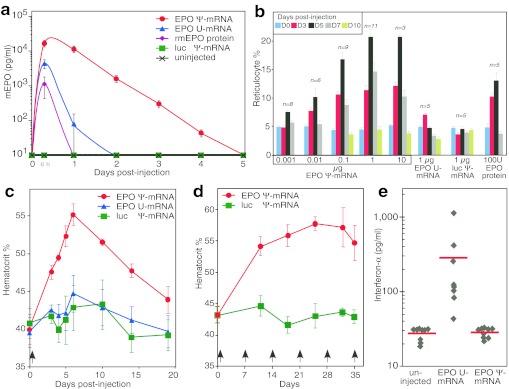Figure 2.
Physiologic responses of mice injected with erythropoietin (EPO) mRNA. (a) Administration of EPO mRNA increases serum EPO levels. Adult mice were injected intraperitoneally (i.p.) with TransIT-complexed mRNA (0.1 µg) coding for murine EPO containing pseudouridine (EPO Ψ-mRNA) or containing uridine (EPO U-mRNA) or coding for firefly luciferase and containing pseudouridine (luc Ψ-mRNA) or with 3 µg of recombinant murine EPO (rmEPO) protein. Serum EPO levels were measured by enzyme-linked immunosorbent assay (ELISA) at the indicated time points. Five animals per condition were analyzed. (b) Increased reticulocyte count following a single injection of EPO mRNA. Mice received a single i.p. injection of the indicated amounts of EPO Ψ-mRNA, luc Ψ-mRNA, or EPO U-mRNA complexed with TransIT or human EPO protein (n = 3–11). Reticulocytes were counted at the indicated days using a 5 µl blood sample. Mice were injected with TransIT-complexed mRNA once with 1.0 µg RNA (c), or weekly (indicated by arrows) with 0.1 µg mRNA (d). Hematocrits were measured using 20 µl of blood. Five animals per group were analyzed. (e) Mice were injected with 1.0 µg of murine EPO mRNA that contained either pseudouridine or uridine, or were left uninjected. Murine IFN-α levels were measured in the plasma at 6 hours post-injection by ELISA. Individual data points and the group average (red line) are shown. Error bars are SEM.

